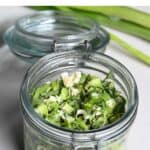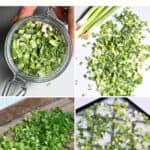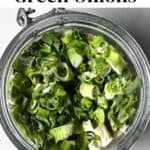This post may contain affiliate links. Please read our disclosure policy.
How to dry green onions (scallions) with and without a dehydrator in just a few simple steps. Perfect for making slices, flakes, and green onion powder to enjoy all year round!
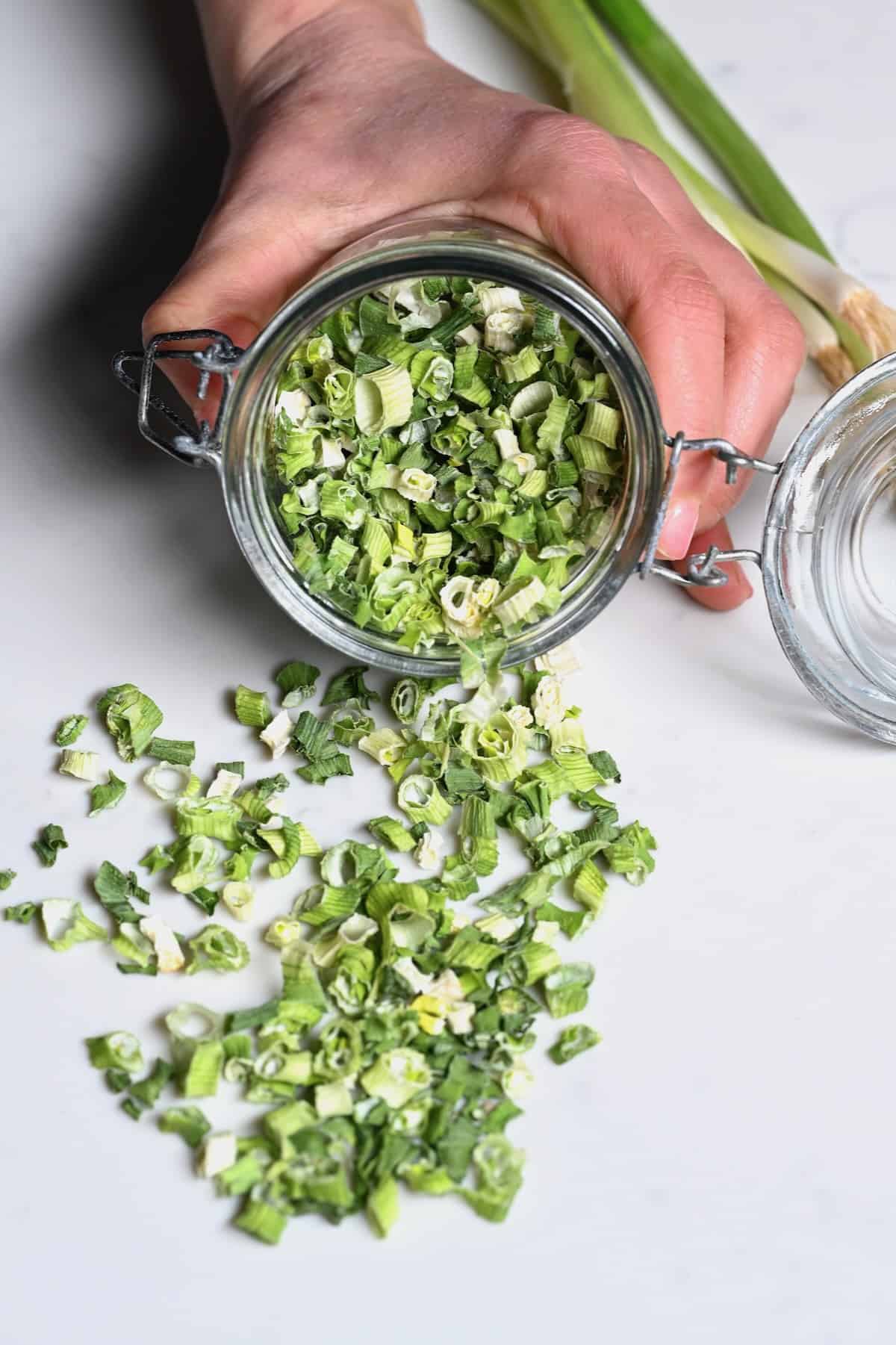
I’ve already shown you how to grow green onions. But what do you do when you suddenly end up with an abundance of green onions and no way to use them all? That is where learning how to dry green onions comes in handy!
Following methods with step-by-step instructions using a dehydrator, oven, or microwave, you can enjoy preserving green onions ready to use in soups, stews, eggs, and more!
Drying green onions at home gives you a fresher, tastier version than store-bought options. Plus it’s also a great way to prolong their shelf life and reduce waste. You might also enjoy drying your own herbs, like dill, mint, thyme, and rosemary!
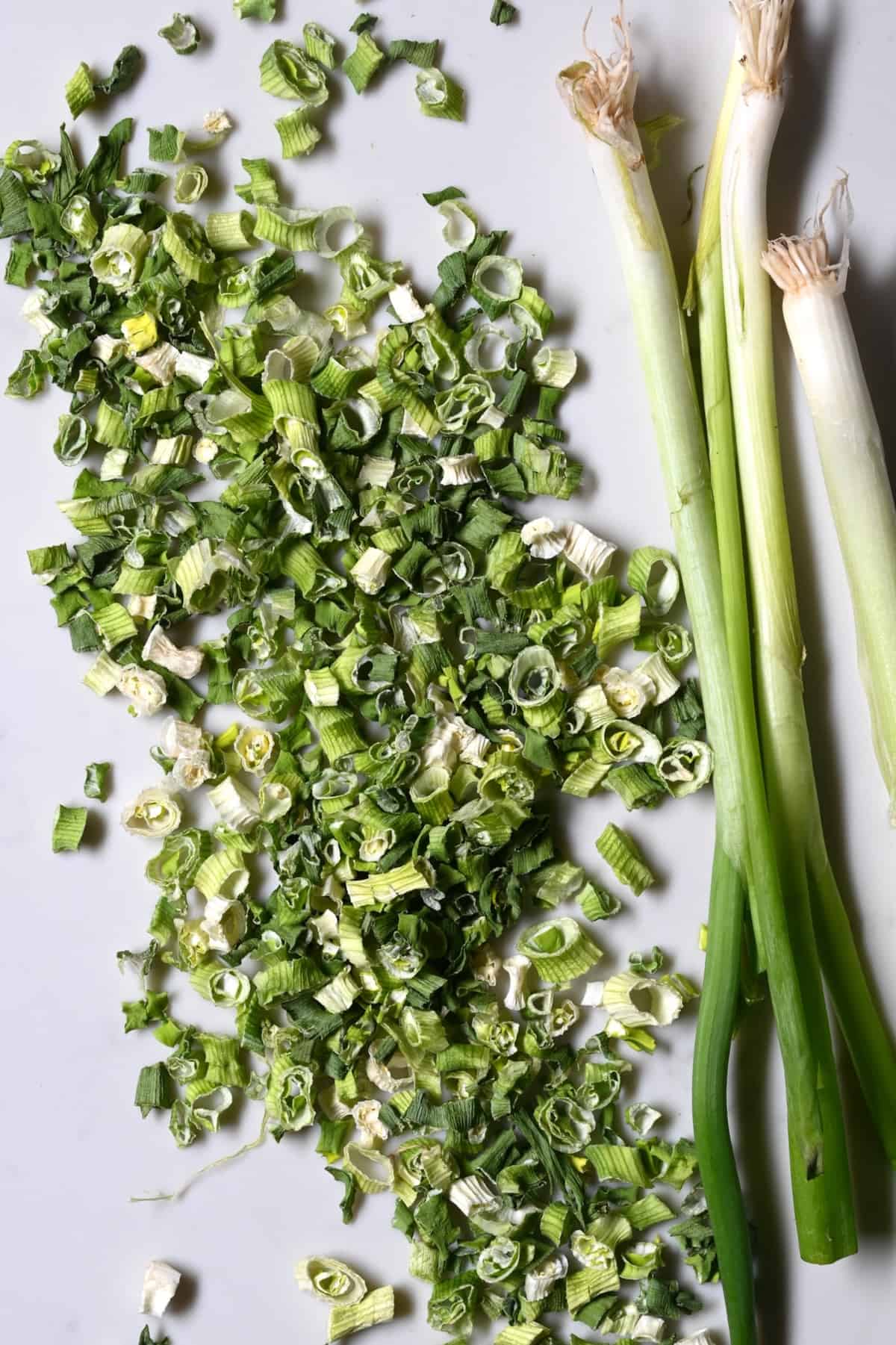
Want to save this recipe?
Table of Contents
Are Green Onions and Scallions the Same Thing?
While there appears to be some confusion about this, yes, green onions and scallions are the same. They have a thin white stem end, vibrant green shoots, and mild onion flavor. Any difference in appearance (usually the size/shape of the whole bulb area) is usually due to when it’s harvested.
In comparison, spring onions look similar but have small onion bulbs at their base with a more intense flavor than scallions. However, in some countries (like the UK and Canada), you’ll find green onions labeled spring onions (which may be where the confusion stemmed from).
How to Dry Green Onions In A Dehydrator
First, before using any of the below methods for dehydrating green onions, you’ll need to prepare them:
- Wash the green onions well, pat them dry, strip any wilting/brown outer layers/leaves, and trim off the root end.
- Then finely chop green onions (with a sharp knife or kitchen scissors) into uniform pieces, about ½ cm wide. Here are more ways to cut them.
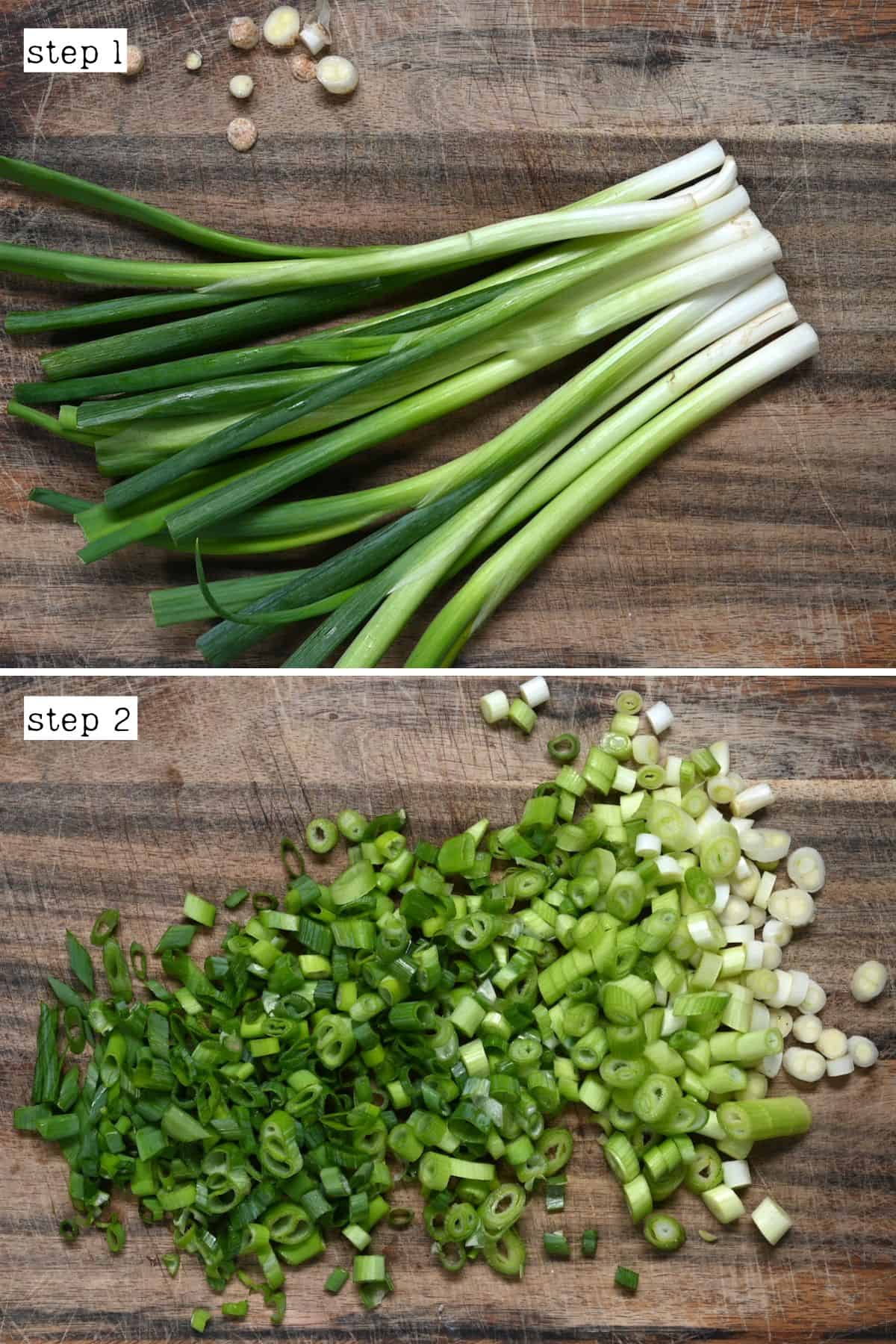
If you leave a bit more of the white bulb, you can save them to replant. It’s incredibly easy to grow/regrow green onions with just the root.
- Spread the pieces evenly across a dehydrator tray, ensuring there is space between them for airflow.
- Dehydrate at 105ºF/40ºC for between 6-8 hours until they are dry enough to snap, not bend.
Note that the dehydrated scallions will continue to dry as they cool, so it’s a good idea to allow a few pieces to cool for 10-15 minutes before testing if they’re brittle.
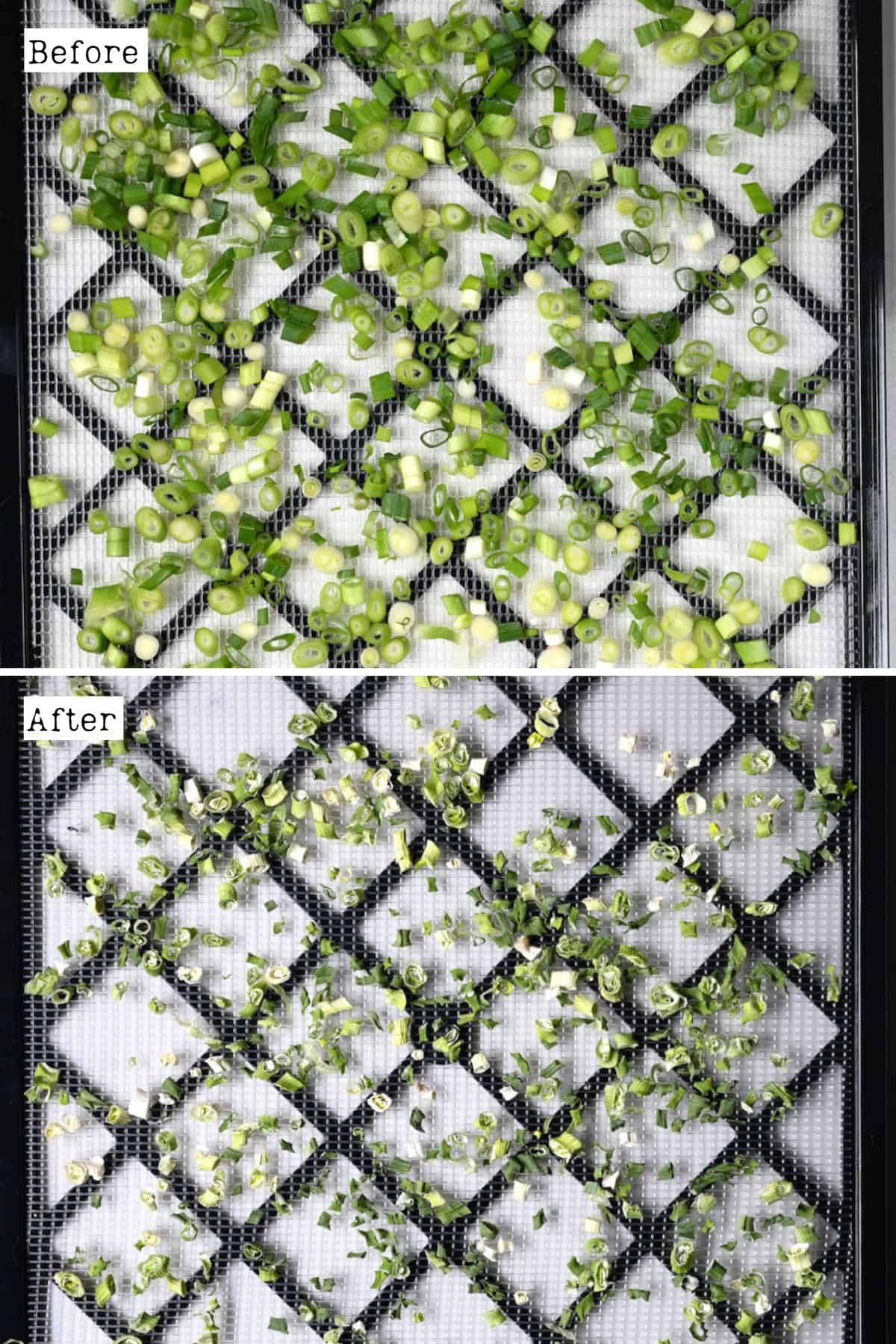
How To Dry Green Onions Without a Dehydrator
If you don’t own a dehydrator, you can still dehydrate green onions easily at home with either an oven or microwave.
In The Oven
- Once cleaned and cut, spread the green onion pieces evenly across a baking sheet lined with parchment paper, with space in between for airflow. Separate the greens and white portions, as the latter takes longer to dry.
- Turn the oven to the lowest temperature, often around 125ºF/52ºC, and dehydrate for between 3-4 hours or until crisp. Monitor them every so often to avoid burning.
Some modern ovens have a dehydrating feature, allowing you to go as low as 105ºF/40ºC (for 6-8 hours).
If your oven only goes as low as 170ºF/75ºC, prop the oven door slightly open with a heat-proof item, like a wooden spoon or silicone spatula end, and dry for 3-4 hours.
In A Microwave
- Spread a layer of sliced green onions between two paper towels without overlapping.
- Microwave in 30-second increments on medium to high power. Between each cycle, check to see if any are dry and remove them. Repeat until all the pieces are brittle and crumbly.
How Long Will Dehydrated Green Onions Last?
As long as you properly dehydrate them before storing them (together or greens and whites separated) in sterilized, dry airtight containers (I use glass jars/mason jars), you can store the dehydrated green onion for up to a year in your pantry. However, they will be freshest within the first 3-4 months.
It’s important to shake the jar once a day for the first few days and see if there’s any clumping/sticking. If so, return them to the dehydrator for longer.
To preserve freshness for longer, you can vacuum pack the dehydrated green onions with a jar vacuum sealer tool. Once open, feel free to add an oxygen absorber if you don’t plan on using them all within a year, to prolong the shelf life.
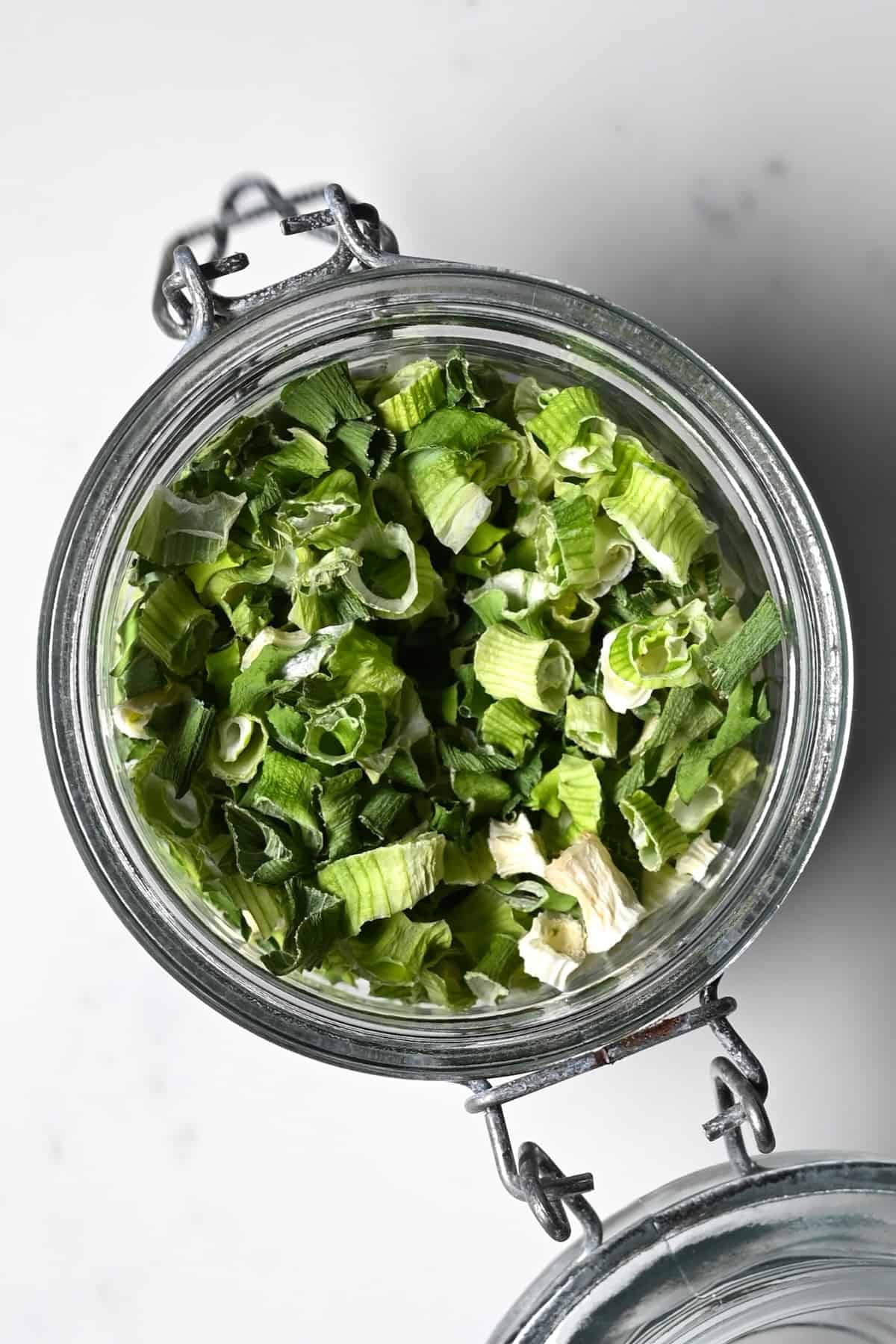
What Can I Do with Dried Green Onions?
Whether you store them in slice form, as flakes, or make green onion powder, there are plenty of ways to use dehydrated green onion to add a delicious oniony depth to dishes:
- Soups and stews (including dry soup mixes),
- Ramen (and homemade “dried noodle” jars),
- Marinades,
- Scrambled eggs,
- Stir-fried rice,
- Mashed potatoes,
- Rehydrate to use in scallion pancakes,
- Rehydrate to use in egg salad, deviled eggs, or potato salad,
- Turn it into green onion salt,
- Add to bakes- like bread, dinner rolls, scones, savory muffins, etc.
- Add to dips, sauces, and gravies.
FAQs
To make green onion flakes, pulse the dried pieces in a blender/food processor (or crush them with a mortar and pestle) to your desired consistency. For a smooth green onion powder, it’s best to use a coffee or spice grinder to do the job.
Note for every ¼ cup of raw green onions, you’ll need a tablespoon of dried or about 1 ½ teaspoons of green onion powder.
Absolutely. You can add them directly into soups and stews to rehydrate. OR rehydrate them in boiling water/stock for about 10 minutes before using them. If you can, I recommend using the soaking liquid, too, as it contains nutrients and flavor, too.
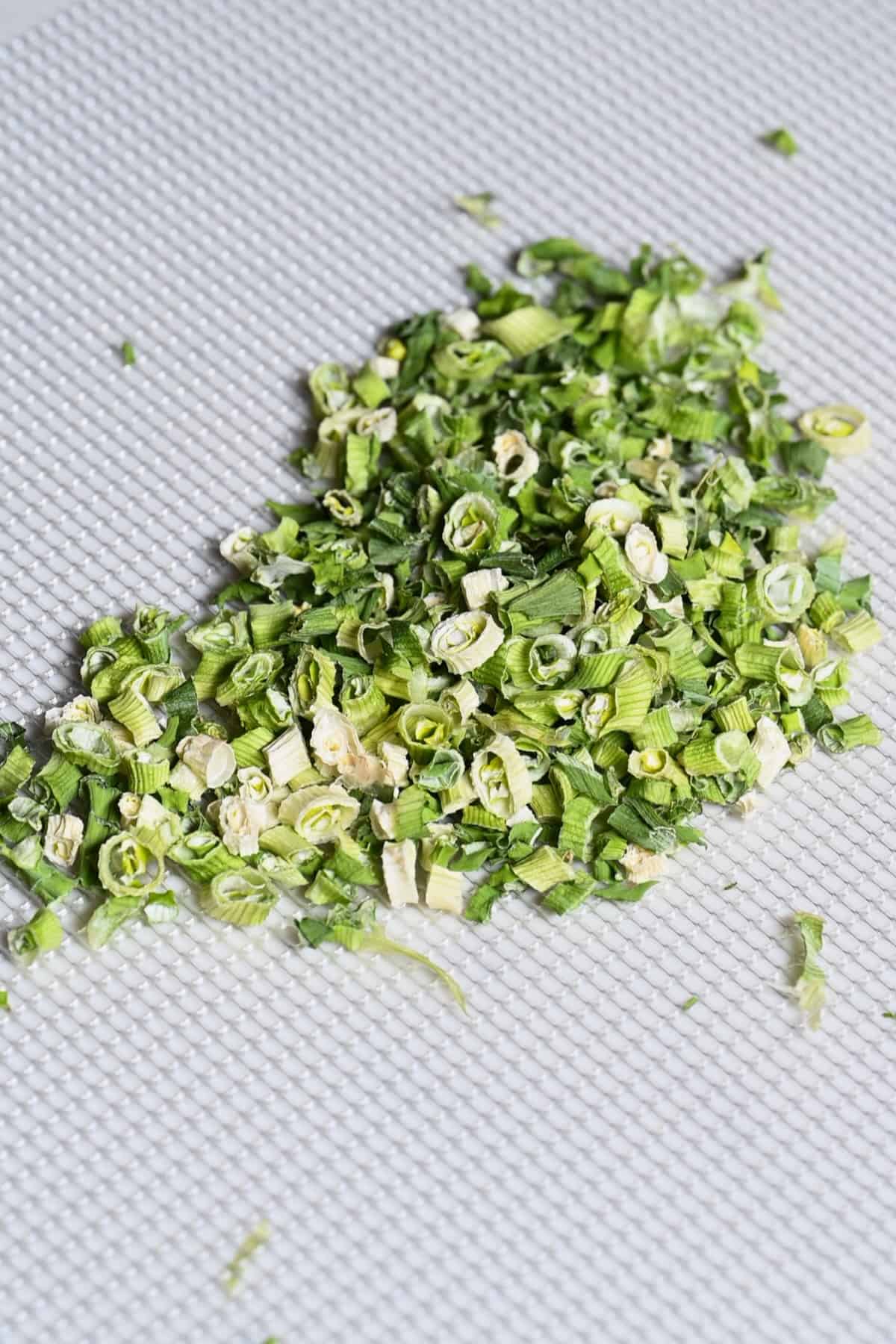
Recipe Tips and Notes
- Cut uniform pieces: To ensure they dry at the same rate.
- Separate greens & whites: The white parts contain more moisture and take longer to dehydrate. So it’s best to keep them on a separate tray/area of the tray. It can help to separate the layers by slicing down the side and pulling the white rings apart.
- Don’t overcrowd them: They need space for airflow to dehydrate properly.
- For smoky flavor: Char the scallions on a grill lightly before dehydrating them.
How to Dehydrate Foods
- Sun-Dried Tomatoes (3 Ways)
- How to Dehydrate Apples
- How To Dry Mushrooms
- Easy Steps to Dehydrate Chives
- 3 Ways to Dry Parsley
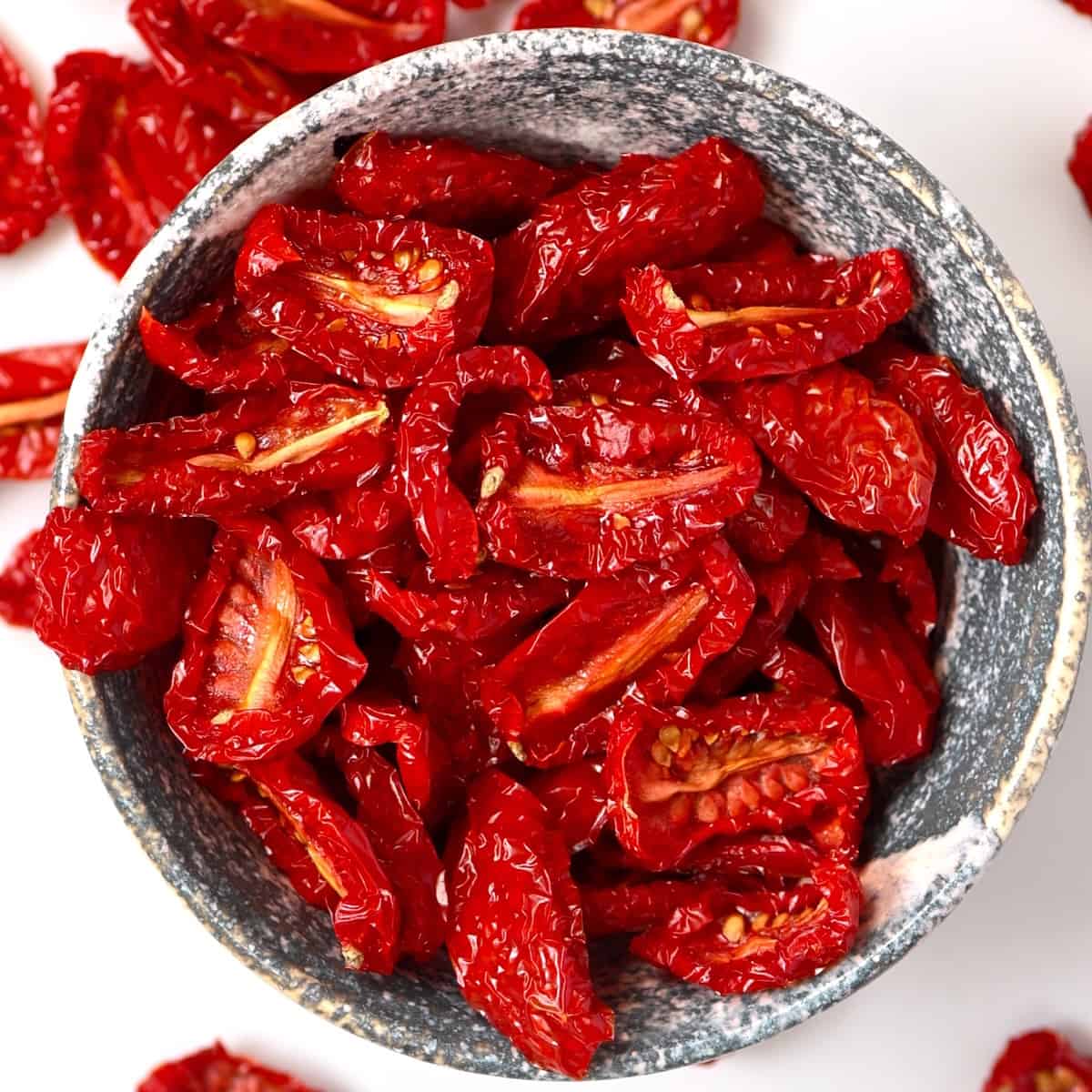
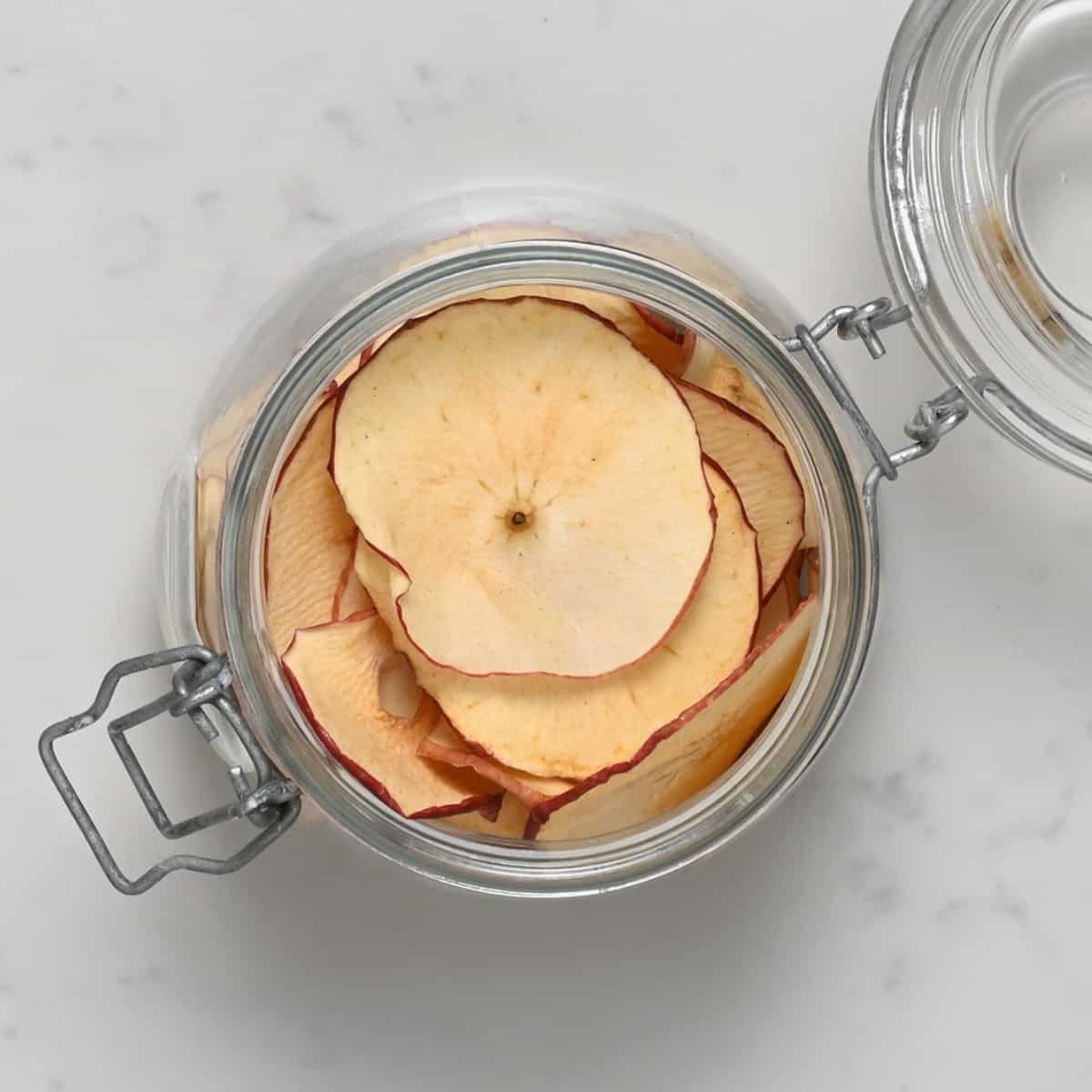
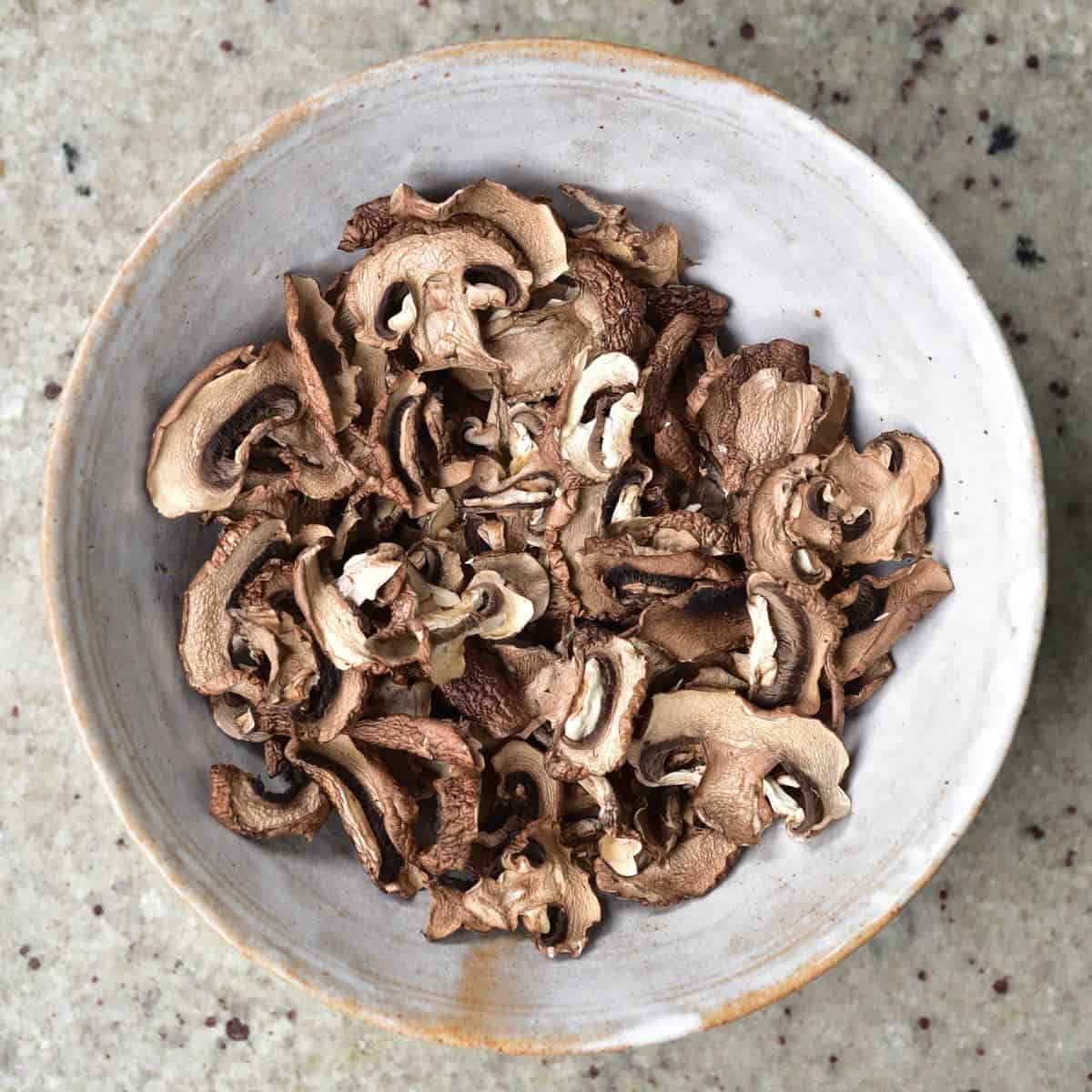
If you try this easy method for how to dry green onions, let me know how it goes in the comments below. I’d appreciate a recipe card rating and would love to see your recipe recreations – tag me on Instagram @Alphafoodie!
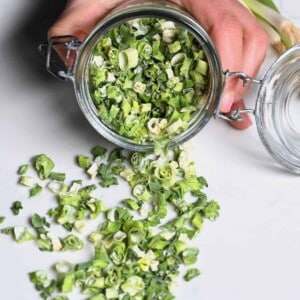
How to Dry Green Onions
Equipment
- Dehydrator or oven or microwave
Ingredients
- 4 oz green onions or more as needed
This will yield about 0.3 oz/9g of dried green onions.
Instructions
Prepare The Green Onions
- Wash the green onions well, pat them dry, strip any wilting/brown outer layers/leaves, and trim off the root end.
- Finely chop green onions (with a sharp knife or kitchen scissors) into uniform pieces, about ½ cm wide.
Using A Dehydrator
- Spread the pieces evenly across a dehydrator tray, ensuring there is space between them for airflow.
- Dehydrate at 105ºF/40ºC for between 6-8 hours until they are dry enough to snap, not bend.Note that the dehydrated scallions will continue to dry as they cool, so it’s a good idea to allow a few pieces to cool for 10-15 minutes before testing if they’re brittle.
In The Oven
- Spread the green onion pieces evenly across a baking sheet lined with parchment paper, with space in between for airflow. Separate the greens and white portions, as the latter takes longer to dry.
- Turn the oven to the lowest temperature, often around 125ºF/52ºC, and dehydrate for between 3-4 hours or until crisp. Monitor them every so often to avoid burning.Some modern ovens have a dehydrating feature, allowing you to go as low as 105ºF/40ºC (for 6-8 hours).If your oven only goes as low as 170ºF/75ºC, prop the oven door slightly open with a heat-proof item, like a wooden spoon or silicone spatula end, and dry for 3-4 hours.
In A Microwave
- Spread a layer of sliced green onions between two paper towels without overlapping.
- Microwave in 30-second increments on medium to high power. Between each cycle, check to see if any are dry and remove them. Repeat until all the pieces are brittle and crumbly.
Storage
- As long as you properly dehydrate them before storing them (together or greens and whites separated) in sterilized, dry airtight containers (I use glass jars/ mason jars), you can store the dehydrated green onion for up to a year in your pantry. However, they will be freshest within the first 3-4 months.It’s important to shake the jar once a day for the first few days and see if there’s any clumping/sticking. If so, return them to the dehydrator for longer.
Notes
- Cut uniform pieces: To ensure they dry at the same rate.
- Separate greens & whites: The white parts contain more moisture and take longer to dehydrate, so it’s best to keep them on a separate tray/ area of the tray. It can help to separate the layers by slicing down the side and pulling the white rings apart.
- Don’t overcrowd them: They need space for airflow to dehydrate properly.
- For smoky flavor: Char the scallions on a grill lightly before dehydrating them.
- To preserve freshness for longer, you can vacuum pack the dehydrated green onions with a jar vacuum sealer tool. Once open, feel free to add an oxygen absorber if you don’t plan on using them all within a year, to prolong the shelf life.
Nutrition
Nutrition information is automatically calculated, so should only be used as an approximation.

